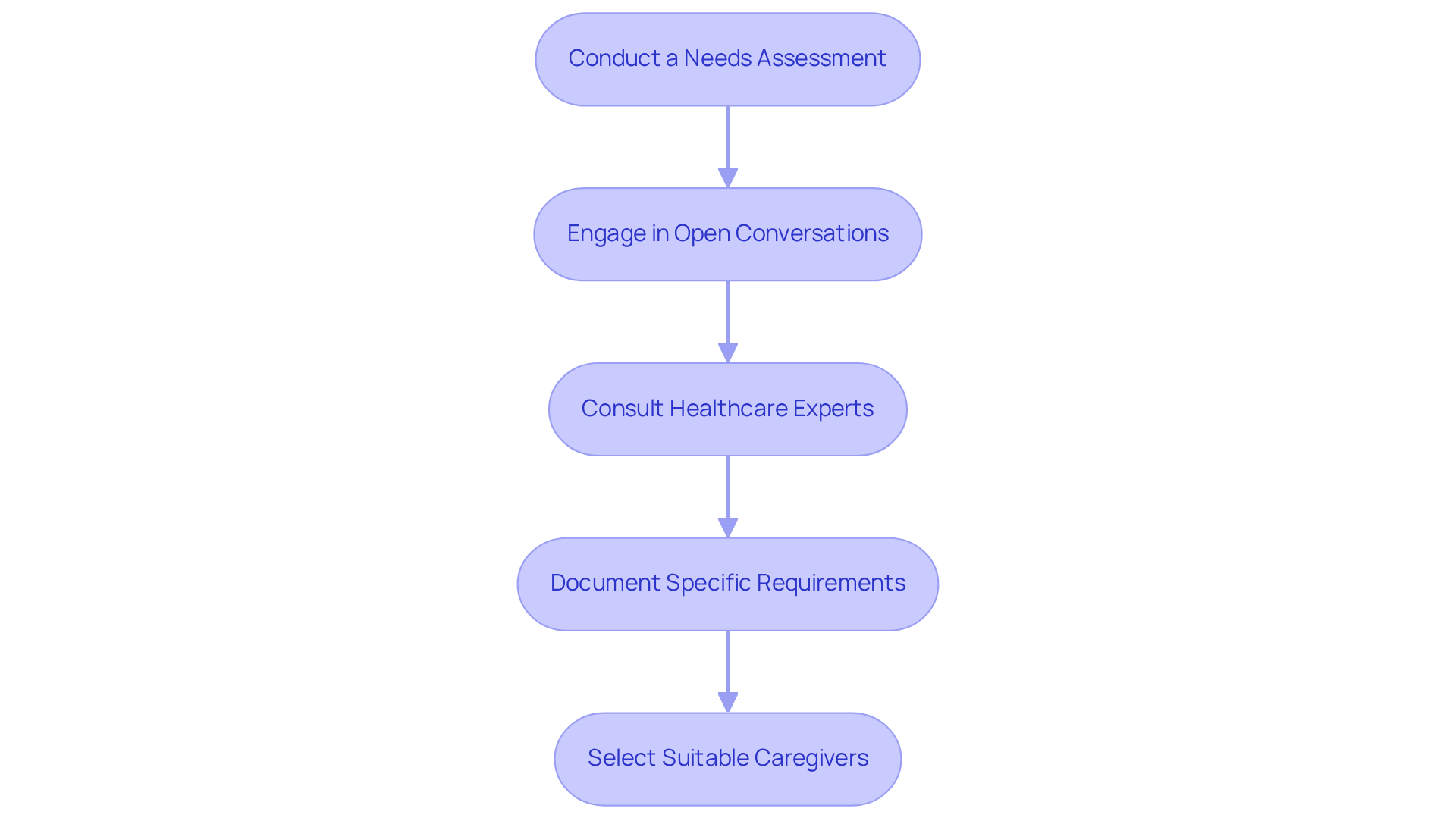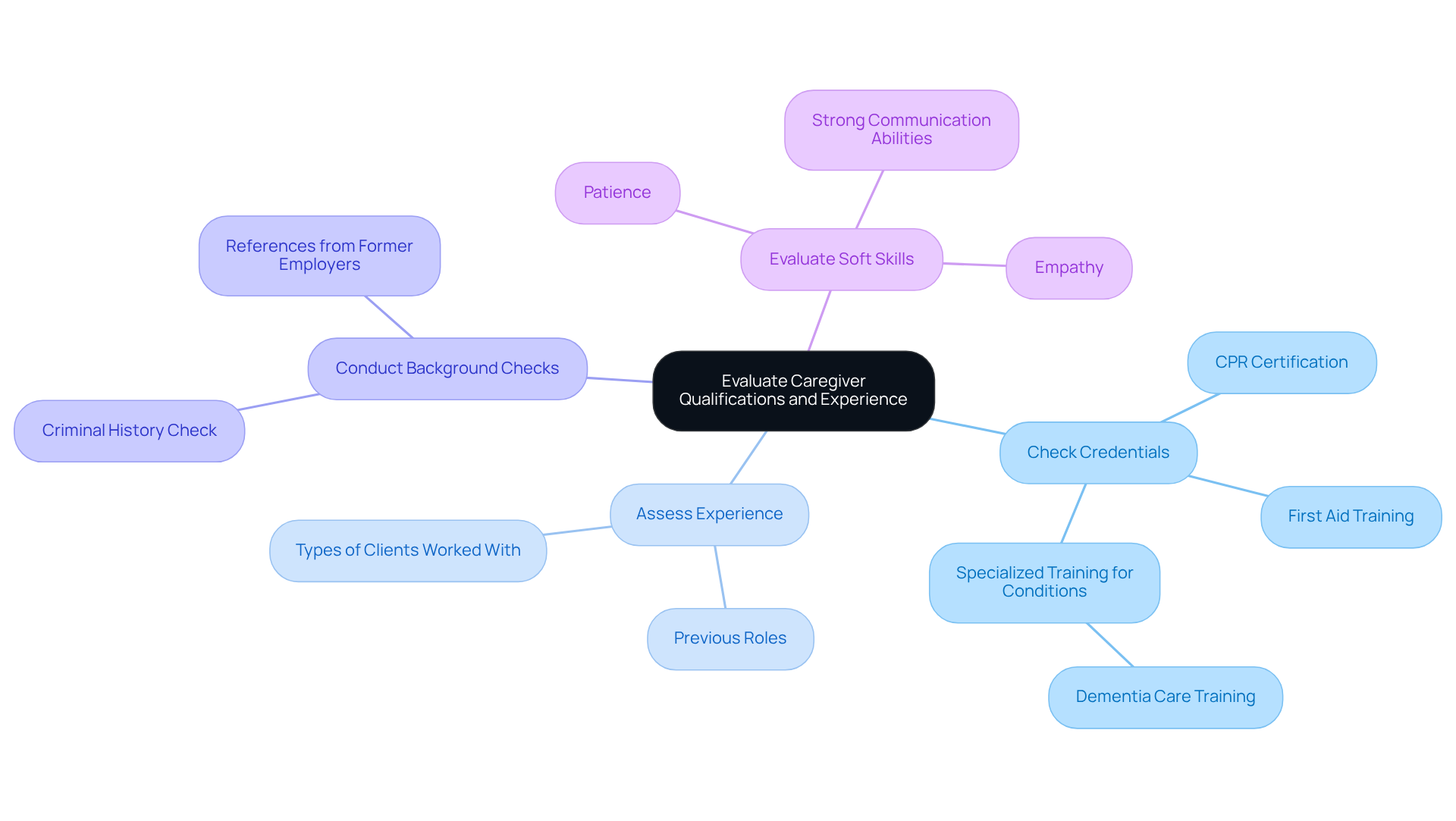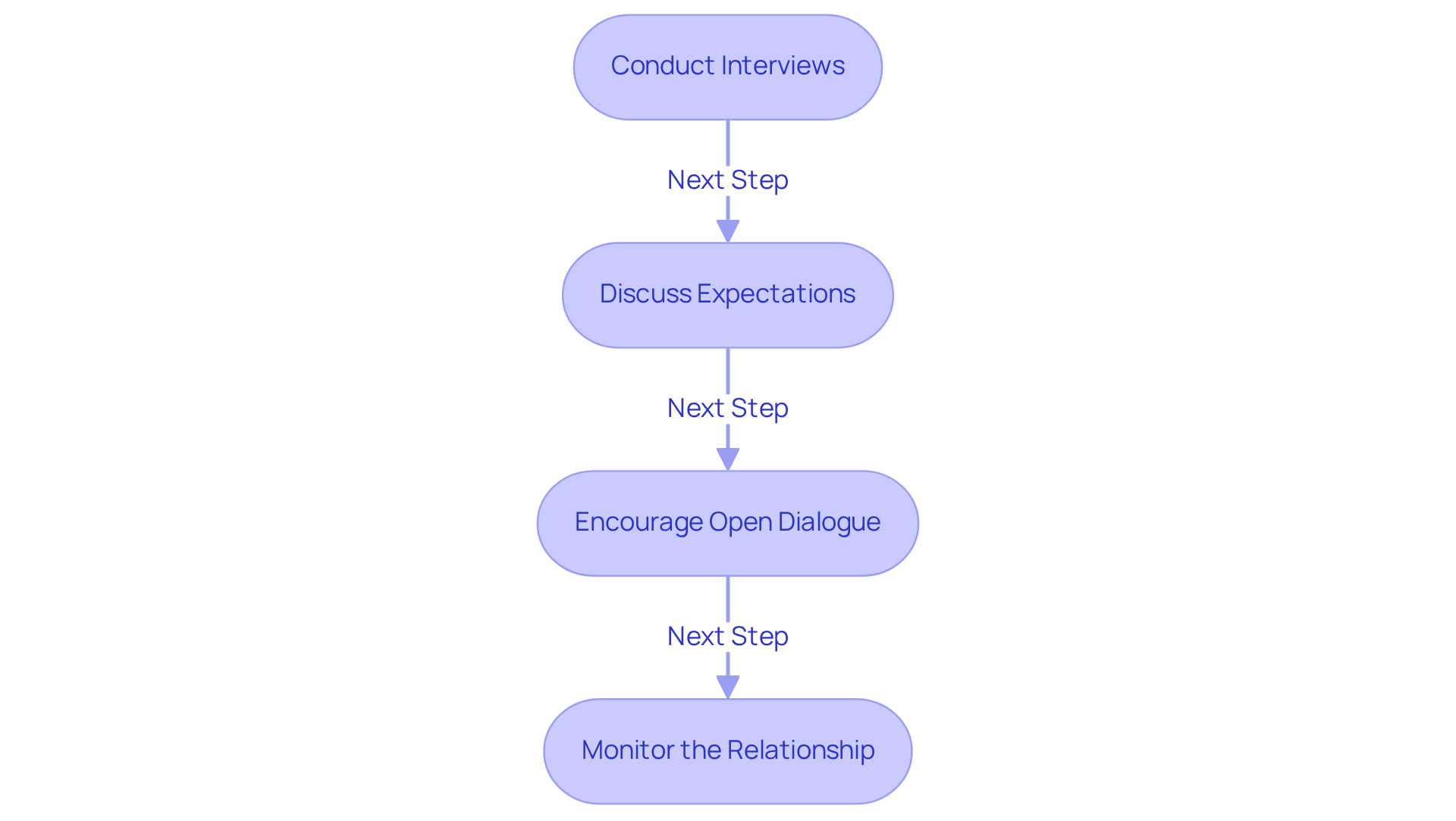Overview
Choosing in-home caregivers for the elderly can feel overwhelming. Families often face emotional challenges, from worry about their loved ones’ well-being to the stress of finding the right support. It’s essential to approach this process with care and understanding.
Start by identifying the types of care services needed. This step is crucial, as it lays the foundation for what your loved one requires. Next, assess the specific needs of the care recipient. Each individual is unique, and understanding their preferences and requirements can make all the difference.
Evaluating caregiver qualifications is another vital step. Look for caregivers who not only have the right skills but also possess the interpersonal qualities that foster a nurturing environment. It’s not just about qualifications; it’s about finding someone who can connect with your loved one on a personal level.
Finally, ensure compatibility through effective communication. This is where the magic happens. Open dialogue can help build trust and comfort, making the caregiving experience more positive for everyone involved.
By understanding service categories and conducting thorough assessments, families can select the right caregiver. Remember, it’s okay to feel stressed or uncertain during this process. You’re not alone, and there are compassionate services available to support you.
Finding the right caregiver is not just about meeting practical needs; it’s about creating a supportive environment where your loved one can thrive. With the right approach, you can ensure that your family member receives the care they deserve.
Introduction
Navigating the world of in-home elderly care can feel overwhelming for families trying to find the best support for their loved ones. It’s a journey filled with emotional challenges, as you want nothing but the best for those who have cared for you. With so many services available, understanding the unique needs of seniors and the qualifications of potential caregivers is essential for ensuring their well-being and comfort.
How can families choose the right caregivers while balancing both emotional and practical considerations? It’s a tough question, but you’re not alone in this. Many families share similar concerns, feeling the weight of stress and uncertainty. This guide aims to simplify the decision-making process, offering essential steps that empower you to provide the best care possible for your elderly relatives. Together, we can navigate this path with compassion and understanding.
Identify Types of In-Home Care Services
Understanding the different types of cuidadores de ancianos a domicilio services can be a comforting first step for families navigating care for their loved ones. Here are some common categories:
-
Companionship Care: This service is all about providing emotional support and companionship to seniors. It helps alleviate feelings of loneliness, which can be a heavy burden. Studies reveal that persistent isolation can negatively impact the health of older adults. In fact, one in three seniors feels isolated and lonely, a situation that can shorten life expectancy even more than being overweight or sedentary. Regular interactions with a companion caregiver can lead to improved physical, mental, and emotional health, ultimately fostering a better quality of life.
-
Personal Care: This involves assistance with daily activities like bathing, dressing, grooming, and meal preparation. Cuidadores de ancianos a domicilio play a vital role in helping seniors maintain their independence while ensuring their safety and comfort at home.
-
Home Health Services: These services provide medical assistance, including nursing support, physical therapy, and medication management. Typically offered by certified specialists, such as registered nurses or physical therapists, this care follows a physician’s directives. Medicare may cover these services if deemed medically necessary, allowing seniors to receive essential health services in the comfort of their own homes.
-
Respite Care: This service offers temporary relief for primary caregivers, allowing them to take a much-needed break while ensuring their loved one is well cared for. It’s crucial for preventing caregiver burnout and maintaining the quality of support for seniors.
-
Palliative Care: This focuses on relieving symptoms and stress associated with serious illnesses, enhancing the quality of life for both the patient and their family. Palliative support can be integrated with curative treatments, ensuring that patients receive comprehensive assistance throughout their healthcare journey.
By understanding these categories, you can better recognize which services offered by cuidadores de ancianos a domicilio align with your family member’s needs. This knowledge ensures they receive the right support to thrive at home.
Assess Your Loved One’s Care Needs
To accurately assess your loved one’s care needs, consider these important steps:
-
Conduct a Needs Assessment: Start by evaluating their physical health, mobility, cognitive abilities, and emotional well-being. Look for signs that they may need assistance, like difficulty with daily tasks or noticeable changes in behavior. Routine health evaluations are crucial; they help avoid unnecessary hospital stays by catching potential health concerns early. This ensures treatment plans are tailored to individual needs, significantly improving the quality of life for seniors. Remember, around 60% of adults in the U.S. are affected by chronic illnesses, making this step even more vital.
-
Engage in Open Conversations: Talk with your loved one about their feelings regarding assistance. Understanding their preferences and concerns is essential for making them feel comfortable with the support they will receive. This open dialogue fosters trust and teamwork, which are key for effective service delivery.
-
Consult Healthcare Experts: Reach out to physicians or geriatric management specialists who can provide insights based on medical history and current health status. Their expertise is invaluable in crafting a comprehensive support plan that addresses both medical and emotional needs. As one geriatric support manager wisely noted, “Evaluating support requirements is essential to guaranteeing that the assistance given corresponds with the person’s distinctive situation.”
-
Document Specific Requirements: Make a list of tasks your loved one struggles with, such as managing medications, preparing meals, or maintaining personal hygiene. This documentation is crucial; it helps identify the type of support needed and ensures that caregivers are well-prepared to meet these challenges.
This thorough evaluation will guide you in selecting the most suitable cuidadores de ancianos a domicilio, ensuring your loved one receives the necessary assistance to maintain their independence and well-being.
Evaluate Caregiver Qualifications and Experience
When you’re looking for the right caregiver for your loved one, it’s important to consider a few key factors that can make all the difference.
-
Check Credentials: Start by verifying that the provider has the necessary certifications and training for the type of care your loved one needs. This might include CPR certification, first aid training, or specialized training for conditions like dementia. Knowing they have the right qualifications can bring peace of mind.
-
Assess Experience: It’s also helpful to find someone with experience in similar situations or specific needs that align with your loved one’s requirements. Don’t hesitate to ask about their previous roles and the types of clients they’ve worked with. This can help you feel more confident in your choice.
-
Conduct Background Checks: Ensuring that the individual has a clean background is crucial. Performing thorough background checks, including criminal history and references from former employers, can help you feel secure in your decision.
-
Evaluate Soft Skills: Beyond technical qualifications, it’s essential to assess the individual’s interpersonal skills. Look for qualities like empathy, patience, and strong communication abilities. These traits are vital for providing effective support and fostering a nurturing environment.
By taking the time to thoroughly assess these factors, you can choose a caregiver who is not only qualified but also a compassionate match for your family member. Remember, you’re not just looking for someone to provide care; you’re seeking a partner in this journey who understands and respects your loved one’s needs.
Ensure Compatibility and Communication
To ensure compatibility and effective communication between the caregiver and your loved one, consider these steps:
-
Conduct Interviews: Schedule discussions between your family member and potential support providers. This helps evaluate their suitability. Pay attention to their interactions and communication styles. Notice how well they connect and understand each other. Active listening during these meetings is essential, allowing both parties to express their needs and preferences clearly.
-
Discuss Expectations: Clearly outline the expectations for support, including daily routines, preferences, and specific needs. This establishes a mutual understanding and lays the groundwork for a positive relationship. Remember, adapting communication styles to fit individual needs can significantly enhance this understanding.
-
Encourage Open Dialogue: Create an environment where both the provider and your loved one feel comfortable expressing their thoughts and concerns. Frequent check-ins can promote open communication, enabling prompt adjustments to treatment plans as needed. Be mindful of potential communication barriers, such as hearing loss or cognitive impairments, which may require you to use clear, simple language and visual aids.
-
Monitor the Relationship: After employing a support worker, continue to observe the relationship and communication dynamics. Ask your loved one about their comfort level and satisfaction with the care provided, ensuring their needs are consistently addressed. Reliable supporters can help establish routines that foster trust and emotional stability.
By prioritizing compatibility and communication, you create a supportive environment that enhances the caregiving experience for both your loved one and the cuidadores de ancianos a domicilio. Effective communication not only improves decision-making about care options with cuidadores de ancianos a domicilio but also builds trust, leading to better health outcomes and overall satisfaction. As Mario Tucker emphasizes, choosing the right caregiver is about connection, compatibility, and ongoing support.
Conclusion
Choosing the right in-home care services for elderly loved ones can feel overwhelming. It’s a decision that weighs heavily on families, as it directly impacts the quality of life for those we cherish. Understanding the different types of cuidadores de ancianos a domicilio and assessing both care needs and caregiver qualifications is essential. This ensures that our loved ones receive the support they deserve in a familiar environment, fostering their independence and enhancing their overall well-being.
Start by identifying the specific types of care services needed. Take the time to conduct thorough assessments of your loved one’s health and emotional needs. Evaluating potential caregivers based on their qualifications and interpersonal skills is crucial. Open communication between caregivers and seniors builds trust and ensures that care plans are tailored to individual preferences. By taking these steps, families can create a nurturing atmosphere that promotes safety and companionship.
Ultimately, selecting the right caregiver goes beyond just meeting physical needs. It’s about fostering meaningful connections and ensuring emotional support. Families should prioritize compatibility and maintain open lines of communication throughout the caregiving process. This approach not only leads to better health outcomes but also enriches the lives of both seniors and their caregivers, making the experience rewarding for everyone involved. Remember, you’re not alone on this journey; compassionate care is available, and it can make all the difference.
Frequently Asked Questions
What are the main types of in-home care services for seniors?
The main types of in-home care services for seniors include Companionship Care, Personal Care, Home Health Services, Respite Care, and Palliative Care.
What is Companionship Care?
Companionship Care provides emotional support and companionship to seniors, helping to alleviate feelings of loneliness and improve their overall physical, mental, and emotional health.
What does Personal Care involve?
Personal Care involves assistance with daily activities such as bathing, dressing, grooming, and meal preparation, helping seniors maintain their independence and safety at home.
What are Home Health Services?
Home Health Services offer medical assistance, including nursing support, physical therapy, and medication management, typically provided by certified specialists following a physician’s directives.
What is Respite Care?
Respite Care provides temporary relief for primary caregivers, allowing them to take a break while ensuring their loved one continues to receive proper care, which helps prevent caregiver burnout.
What is the focus of Palliative Care?
Palliative Care focuses on relieving symptoms and stress associated with serious illnesses, enhancing the quality of life for both the patient and their family, and can be integrated with curative treatments.
How can understanding these types of care services help families?
Understanding these types of care services helps families recognize which services align with their loved one’s needs, ensuring they receive the right support to thrive at home.





